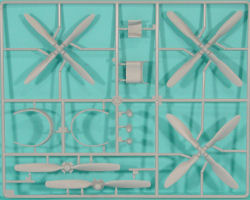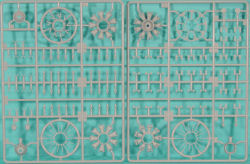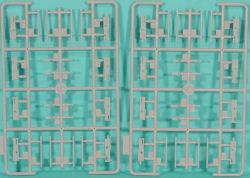
Trumpeter 1/32 P-47N Thunderbolt Kit First Look
By Michael Benolkin
| Date of Review | May 2008 | Manufacturer | Trumpeter |
|---|---|---|---|
| Subject | P-47N Thunderbolt | Scale | 1/32 |
| Kit Number | 2265 | Primary Media | Styrene, Photo-Etch |
| Pros | Superdetailed and superbly engineered | Cons | |
| Skill Level | Intermediate | MSRP (USD) | $124.95 |
First Look
 |
 |
 |
 |
 |
 |
 |
 |
 |
 |
 |
 |
 |
 |
 |
The Republic P-47 first took shape as the Seversky P-35 before that company became Republic. The design was evolved through the P-43 Lancer before the requirements led to World War II's heaviest fighter, the P-47.
The P-47 was designed with the typical streamlined cockpit of the day before rearward visibility in aerial combat became a requirement. Later P-47s were redesigned with the rear upper deck cut down to facilitate a bubble canopy atop the fuselage which provided excellent all-round visibility. This new design was introduced part-way through P-47N production, which for whatever reason didn't warrant a new model designation.
P-47s were among the first fighters to accompany the USAAF over to Europe as the United States entered the war. While many fighter wings were quick to transition to the P-51 Mustang as soon as it was available, the 56th Fighter Group was one of the only organizations to refuse the Mustang and see the war through in their beloved Thunderbolts.
As the war in the Pacific raged on, Thunderbolts in that theater were getting their range extended with enlarged internal tanks and drop tanks. The only way to get the Thunderbolt to fly further was to enlarge the wings and add fuel tanks in the new spaces in the wing. The larger wing added an additional 100 gallons of fuel and extended the range to around 2000 miles. These new Thunderbolts were designated as the P-47N and were the last production version to see service. Before the Republic production line closed shortly after World War II, over 1800 P-47Ns had been produced with total production of the Thunderbolt exceeding 15,600.
Several months ago, Trumpeter released their 1/32 scale P-47D Razorback Thunderbolt kit which is an AMS modeler's dream ( look here). Shortly thereafter, Trumpeter released the Bubbletop P-47D ( look here). Now they're back with the largest of the Thunderbolts, the P-47N. If you look at the parts trees, you'll note that most of the trees are in common with the other releases and the fuselage in particular with the Bubbletop P-47D, but that wing is all-new tooling.
This kit is molded in the usual Trumpeter light gray styrene and presented on fifteen trees, plus two trees molded in clear, and a separate clear cowling. A small fret of photo-etched parts is also included containing seatbelts, shoulder harnesses, radiator grilles, and compressor blades. The main gear and tailwheel tires are rubber, as are the .50 caliber ammo belts.
The detailing on the kit's surfaces is finely scribed and include lots of rivet details. Since the P-47N remained mostly bare metal, these details will be visible but will also draw the observer's eyes into the rest of the detail as well.
The cockpit is very nicely detailed and will only require some careful painting to make the details stand out. Like most Trumpeter releases, the instrument panel is enhanced with instrument faces printed on clear acetate that will align behind the instrument panel itself. The look is quite realistic.
While the cockpit is nice, the engine is a magnificent work of art. There is good reason to provide the cowling in clear, though you might want to leave the cowling off altogether. This engine is easily one of the most detailed they've done to date and would most definitely look great off the aircraft and on an engine stand. The problem is that the engine doesn't stop at the firewall. Trumpeter has recreated all of the ductwork for the aircraft's supercharger system that sits in the rear fuselage behind the side vents. The supercharger itself has a photo-etched compressor, but there is just no way to see any of that detail unless you leave one side of the kit fuselage off.
The engine, firewall, ductwork, and supercharger make into a huge assembly that also serves as the mounting point for the cockpit tub before the whole thing goes inside the fuselage halves. This assembly also has wing main spars, fore and aft, which the assembled wings will slide over and provide a good mechanical mounting as well as ensuring proper dihedral.
The flight control surfaces and landing flaps are all molded separately and can be positioned to taste.
One of the most common mistakes made with P-47 kits is the alignment of the leading edge machine gun holes. Some manufacturers see the restored Thunderbolts out there and assume these are accurate. One of the odd design quirks of the aircraft was when Republic mounted the machine guns to be horizontal to the ground rather than aligned with the centerline of the wing leading edge. This would be the line that runs from the wing root to the wing tip when viewed from the front. Check out photos of the combat P-47s, not the restorations, and see how the inboard machine gun hole sits above the wing leading edge centerline whilst the outboard gun is below that same line.
The gun bays are nicely laid out with the ammo troughs and gun mounts, with each of the eight machine guns provided as well.. The gun doors atop the wing are molded separately so they can be positioned open or closed.
As mentioned before, the cowling is clear, though the lower duct walls that sit at the bottom of the cowling and the cowl flaps are gray styrene. You do have your choice of open or closed cowl flaps.
The kit provides FOUR different propellers, so you can select the propeller used by the aircraft you're representing - check your references.
External stores include:
- ten rockets on underwing stubs
- two 500 pound bombs
- two 250 pound bombs
- two 150 gallon metal drop tanks
- two 75 gallon metal drop tanks
- two 108 gallon paper drop tanks
- two 108 gallon flat metal tanks
Markings are provided for two aircraft:
- P-47N, 44-88211, 146, 464 FS/507 FG, le Shima, 1945, 'L'il Meatie's Meat Chopper' as flown by Lt Oscar Perdomo
- P-47N, 44-88043,21, 333 FS/318 FG, le Shima, 1945, '2 Big and Too Heavy/Snort Snorter'
The color profiles in the kit use Gunze Sangyo color numbers, some of which are from the discontinued colors of Gunze Aqueous line. The decals also include a set of maintenance stencils.
But there are three sets of decals. The first is the large sheet with the distinctive markings for both aircrafts, the second has the national markings and the maintenance stencils, whilst the third is a specially protected sheet using a different color process to render that lovely nose art for the 2 Big and Too Heavy aircraft. Trumpeter continues to step up their game!
So far, Trumpeter and Hasegawa have been battling it out with competing Thunderbolts, though so far it appears that Hasegawa completed their line-up with the P-47M and Trumpeter with the P-47N. I've been asked which kit is better and I have to answer with "it depends". If you want a simple build with nice detail that goes together quickly, the Hasegawa kit is for you. On the other hand, if you want to play with all of the details and show off the engine, ducting, supercharger, and other AMS-derived fun, then there is no other choice - the Trumpeter kit is still second to none.
My sincere thanks to Stevens International for this review sample!







